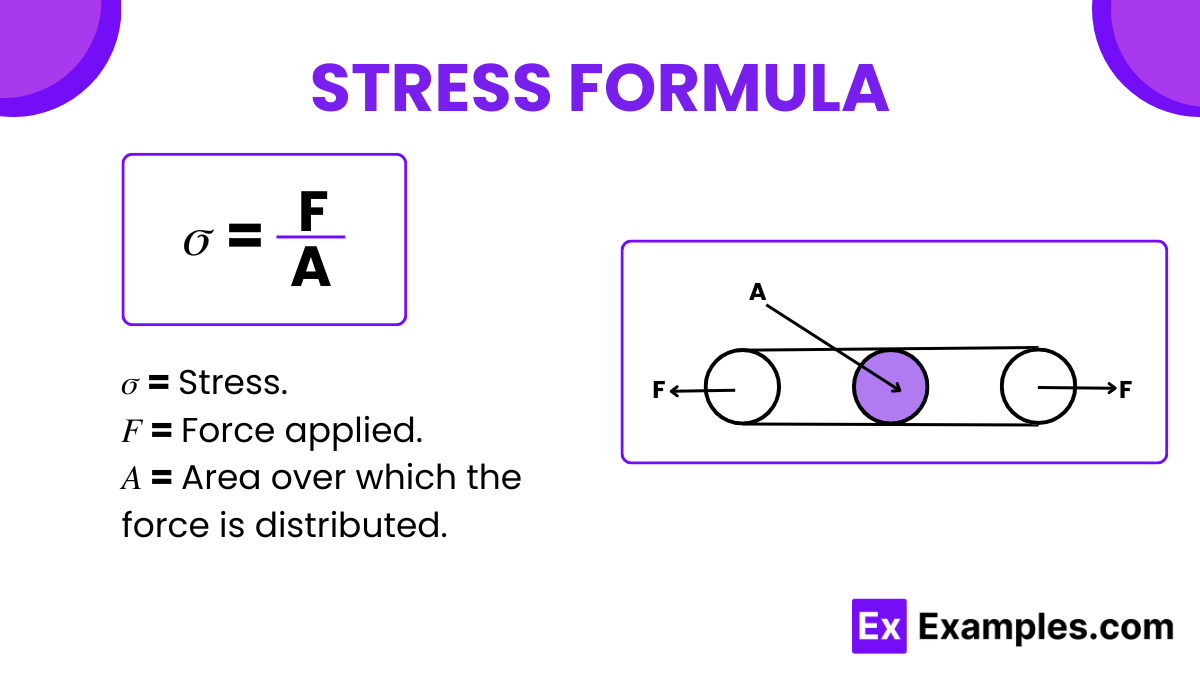What is the general formula for stress?
σ = F/A
σ = F*d
σ = F/m
σ = F/v


The stress formula in physics quantifies the amount of internal force exerted per unit area within a material. This formula is essential for understanding how materials deform under various forces, a fundamental concept in the field of physics and engineering. we express the formula for stress as
This concept was developed by Thomas Young, an English polymath, who first described it in the early 19th century. Young’s work laid the foundation for modern material science, particularly in understanding elasticity and structural integrity. The stress formula helps engineers and physicists predict how materials will behave when subjected to different forces, which is critical in designing safe and effective structures, from bridges to airplanes.
Question: A force of 5000 Newtons is applied to a rectangular beam with a cross-sectional area of 0.1 square meters. Calculate the stress on the beam.
Solution: 𝜎 = 𝐹 / 𝐴 = 5000 N / 0.1 m² = 50000 Pa
The stress on the beam is 50000 Pascals.
Question: A thin steel wire with a diameter of 0.5 mm is subjected to a tension force of 300 Newtons. Calculate the stress experienced by the wire.
Solution: First, calculate the cross-sectional area 𝐴 of the wire using the formula for the area of a circle, 𝐴=𝜋𝑟², Where r is the radius.
𝑟=0.5 mm / 2 =0.25 mm=0.00025 m
𝐴 = 𝜋(0.00025 m)² ≈ 1.963×10⁻⁷ m²
Now, apply the stress formula:
𝜎 = 𝐹𝐴 = 300 N / 1.963×10⁻⁷ m² ≈ 1.528 × 10⁹ Pa
The stress on the wire is approximately 1.528 GigaPascals (GPa).
Question: Two columns, one with a circular cross-section of radius 10 cm and another with a square cross-section of side 20 cm, each bear a load of 10000 Newtons. Which column experiences more stress?
Solution: Calculate the area for each column:
Circular column area 𝐴₁ = 𝜋𝑟²
𝑟=0.1 m
𝐴₁ = 𝜋(0.1 m)² = 0.0314 m²
Square column area 𝐴₂ = 𝑠²
𝑠 = 0.2 m
𝐴₂ = (0.2 m)² = 0.04 m²
Now, calculate the stress for each column:
Circular column: 𝜎₁ = 10000 N / 0.0314 m² ≈ 318471 Pa
Square column: 𝜎₂ = 10000 N / 0.04 m²=250000 Pa
The circular column experiences more stress than the square column because it has a smaller cross-sectional area.
Stress measures internal force per unit area within materials, quantified in Pascals (Pa).
To calculate total stress, use the formula 𝜎=𝐹𝐴, where 𝐹 represents the force and 𝐴 represents the area.
Calculate stress by dividing the force applied (𝐹) by the area (A): 𝜎=𝐹𝐴.
Text prompt
Add Tone
10 Examples of Public speaking
20 Examples of Gas lighting
What is the general formula for stress?
σ = F/A
σ = F*d
σ = F/m
σ = F/v
In the stress formula σ = F/A, what does F represent?
Force
Area
Area
Length
What is the unit of stress in the International System of Units (SI)?
Pascal (Pa)
Newton (N)
Joule (J)
Watt (W)
How does increasing the cross-sectional area (A) affect the stress (σ) for a given force (F)?
Stress increases
Stress decreases
Stress remains the same
Stress becomes zero
Which type of stress occurs when a material is stretched?
Compressive stress
Tensile stress
Shear stress
Thermal stress
What is compressive stress?
Stress that acts parallel to the surface
Stress that acts perpendicular to the surface and compresses the material
Stress that acts perpendicular to the surface and stretches the material
Stress that acts due to temperature changes
How is shear stress different from tensile stress?
Shear stress acts parallel to the surface, while tensile stress acts perpendicular
Shear stress acts perpendicular to the surface, while tensile stress acts parallel
Shear stress increases volume, while tensile stress reduces volume
Shear stress acts due to temperature, while tensile stress acts due to force
In which unit is shear stress typically measured?
Pascal (Pa)
Newton (N)
Joule (J)
Watt (W)
What happens to the stress in a material if the applied force is doubled while the cross-sectional area remains constant?
Stress is halved
Stress remains the same
Stress doubles
Stress becomes zero
What type of stress is experienced by a material when it is twisted?
Compressive stress
Tensile stress
Shear stress
Torsional stress
Before you leave, take our quick quiz to enhance your learning!

